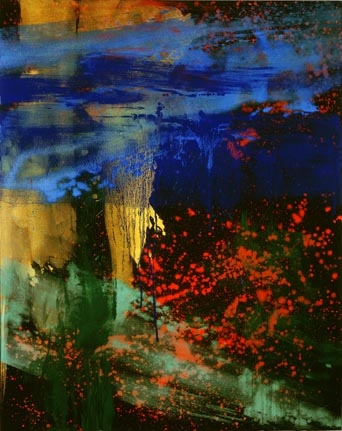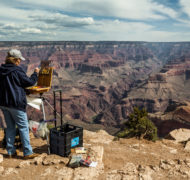
Credit: Makoto Fujimura and Crossway publishing / Used with permission.

Why do we create art? Is it a waste of time and money? Why do we purchase music, enjoy concerts, go to movies, buy original paintings or sculptures, read novels or books of poetry? Couldn’t that money be better used? It's because, deep down, we believe that Art Matters!
“We don’t need a fancy worship area,” Ben said. “All we should make is a simple space where the preacher and choir can lead us each Sunday.”
I was on a church building committee years ago. The church had outgrown the basic rectangular wood-frame building we were in. It was time to create a real church sanctuary.
We sat around a table in one of the sparse adult classrooms, white walls with nothing on them, brown carpet to hide the coffee stains. Ben (not his real name) led a contingent of elders of what I thought of as “The Utilitarians,” who wanted the same kind of simple, pragmatic construction of the original building.
Another elder, Greg, led the group that we can call “The Idealists.” Greg countered by saying, “We should hire a top-notch architect to make a facility that is awe-inspiring for God’s glory.”
Another elder piped in. “And we could also commission artists to create paintings to make the church building as beautiful as possible!”
The Utilitarians did not like these ideas. “What a waste of money! We should spend as little as possible on the building. How can we be extravagant on a building when people are perishing without Jesus as their savior?”
I just sat there not knowing what to think. As I listened to the debate, I couldn’t decide who was right. My heart wanted us to build the idealistically beautiful building, but the pragmatic side of me thought that utility should determine these kinds of decisions.
It has taken me a long time to understand how to navigate such dilemmas. I’ve discovered that being a Christian does not mean that all my decisions have to be based merely on utility.
I resonate with Lynn Morrissey’s story of how she had moved away from her love of singing. Many of us have been through a time when we thought certain things were superfluous and therefore dispensable in our lives. In “How Can I Keep from Singing?” Lynn writes that when life got busy, she decided that singing was not a priority, so she quit the choruses that she enjoyed so much.
Yet somewhere deep within, I continued to hear a faint and far-off hymn, an echo of my soul, an echo of my past, an echo of singing.
But some things that might seem unneeded are actually a vital source of joy, Lynn discovered that she didn’t have to sing in public to fulfill who she is as a singer.
In an essay entitled "The Extravagance of God," artist Makoto Fujimura reflects on the story of when Mary anointed Jesus’s feet with expensive perfume. Some that were present, chiefly Judas, objected. “Why this waste of perfume? It could have been sold for more than a year’s wages and the money given to the poor” (Mark 14:4).
Fujimura believes that the work of artists parallels this extravagant devotion. He writes,
All the time and money that goes into making someone a proficient (let alone a master) Chopin player are extravagant. Are piano lessons worth all the time and cost? In my own work, I use such expensive materials, I often have to weigh what my family will eat that week with what I can order for materials. Why do I use such expensive mineral pigments and gold?
This is the tension we all experience, isn’t it?
Why do we create art? Is it a waste of time and money?
Why do we patronize the arts? Why do we purchase music, enjoy concerts, go to movies, buy original paintings or sculptures, read novels or books of poetry? Couldn’t that money be better used?
But in that biblical passage, Jesus rebukes Judas and the others, saying, “Leave her alone. Why are you bothering her? She has done a beautiful thing to me” (Mark 14:6-8).
Fujimura writes,
What a commendation! What hope these words give to present day Marys like us. Because the sad truth is that even if our offerings are made in pure adoration to the Father and our creative acts reflect him, our friends, our families, and our churches may not fully comprehend our acts of adoration.
Skinny Artist makes the case that being an artist is a legitimate vocation:
Even though we seem to live in a world that is dominated by the bottom line, there is still a need for the artists and poets to show us its beauty and meaning. To be that voice that reveals the larger picture that surrounds us, and to remind us how we are all connected to one another.
Barb Hoffman Knuckles echoes this in “The Work of Holy Artistry:”
Art is work. Frustrating, joyful, and occasionally effortless. So much of one’s being is poured in, with so few conventional rewards … And yet, artists keep making art.
In “Looking for God in Films,” Craig Detweiler tells stories showing the hard work of independent filmmakers.
Their films often wade into social problems that Hollywood tends to ignore. The stories can be thorny, depressing, and inspiring all at the same time.
In an informative section, Craig explains how the Church used to not only embrace but also commission great works of art. I could have used this insight back in that church building committee.
Pope Julius II commissioned Michelangelo to produce some of the world’s greatest masterpieces. Crowds still crane their necks to study his ceiling painting in the Sistine Chapel. Thank God for the French Cardinal who hired Michelangelo to create the Pietà.
I wish I had read that all those years back while in those building committee meetings. So much for utilitarianism.
_____
Painting:
"Charis-Kairos (The Tears of Christ)"
by Makoto Fujimura
80x64", Mineral Pigments, Gold on Belgium Linen
Artist's note from Makoto Fujimura:
"Charis (Grace) Kairos (Time), takes the methods I developed for my Soliloquies series which exhibited my large scale works with Modernist master Georges Rouault's paintings. Taking Rouault's indelible images as a cue, I decided to start with a dark background, to illumine the darkness with prismatic colors. I write in the introduction to the Four Gospels project by Crossway: 'I painted the five large-scale images that illuminate this volume, The Four Holy Gospels, using water-based Nihonga materials (Japanese style painting), with my focus on the tears of Christ (John 11) - tears shed for the atrocities of the past century and for our present darkness.'"